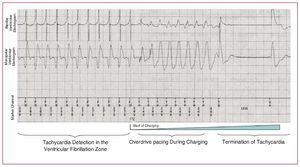Programming of antitachycardia pacing in implantable cardioverter-defibrillators (ICDs) has reduced inappropriate device shocks to terminate ventricular arrhythmia. This implies reductions in distress and pain for the patient and prolongs the useful life of the device. Arrhythmia detection and treatment with ICDs can be programmed according to the arrhythmia ventricular rate, discriminating between 2 detection zones: ventricular tachycardia (slower rhythms) and ventricular fibrillation (faster rhythms). We now know that antitachycardia pacing can also be effective in fast arrhythmia that has been treated classically with device intervention because it is classified within the ventricular fibrillation zone. There is some concern that with antitachycardia pacing, arrhythmia may accelerate and definite treatment by shock may be delayed, with a risk of syncope. To resolve these limitations, new ICD models allow the use of programmable antitachycardia pacing in the fibrillation zone at the initiation of device charging following detection of the arrhythmia. If it is effective, the shock is aborted, whereas if it is not, the shock is applied without any delay (Figure). This new algorithm allows further reductions in the number of device responses, with the consequent benefits on the patient's quality of life and longevity of the generator.
Figure 1


